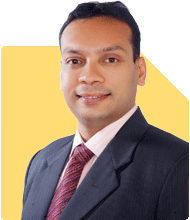Ramalingam Kalirajan |6505 Answers |Ask -Follow
Mutual Funds, Financial Planning Expert - Answered on Jul 06, 2024
He has an MBA in finance from the University of Madras and is a certified financial planner.
He is the director and chief financial planner at Holistic Investment, a Chennai-based firm that offers financial planning and wealth management advice.... more

Sir I have LIC jeevan saral policy running for last 10 years. If I surrender it today, I get 7.2 L. Please advice where should I invest it ( lumpsum or elsewhere), keeping a horizon of 5-10 years for maximum returns.
Understanding Your Financial Goals
To start, let's define your goals more clearly. With a horizon of 5-10 years, it seems you’re looking to achieve significant growth without taking on excessive risk. Are you aiming for higher returns, steady growth, or a balance of both? Clarifying this will guide us in choosing the right investment strategy.
Assessing Risk Tolerance and Investment Strategy
Before diving into specific investment avenues, consider your risk tolerance. Since you have a medium-term horizon, you might be comfortable with a balanced approach that includes both growth and stability. Let’s look at some options that can provide good returns while balancing risk and security.
Investment Options for Rs. 7.2 Lakhs
1. Mutual Funds: A Balanced Portfolio
Mutual funds offer diversified exposure to various asset classes. Given your horizon, a mix of equity and debt funds can be optimal.
Equity Mutual Funds: These funds invest in stocks and have the potential for high returns. Over a 5-10 year period, equity mutual funds can outperform most traditional saving instruments. However, they come with higher volatility. Consider large-cap or multi-cap funds, which invest in well-established companies and provide stable growth.
Debt Mutual Funds: These funds invest in fixed-income securities like bonds and government securities. They offer lower but more stable returns compared to equity funds. Including debt funds can reduce overall portfolio volatility and provide some level of predictability. Options like corporate bond funds or dynamic bond funds could be suitable.
Balanced or Hybrid Funds: These funds invest in a mix of equity and debt. They aim to provide moderate returns with lower risk compared to pure equity funds. A balanced advantage fund or aggressive hybrid fund could be a good middle ground.
Advantages: Diversification, professional management, liquidity.
Disadvantages: Market risk, costs associated with fund management.
Strategy: You could allocate 60% to equity funds and 40% to debt funds to maintain a balanced approach. Review and rebalance the portfolio periodically to stay aligned with your goals.
2. Systematic Investment Plan (SIP) in Mutual Funds
Instead of investing the entire Rs. 7.2 lakhs at once, you might consider spreading it over time through a SIP. This method averages out the purchase price and reduces the impact of market volatility.
SIP in Equity Funds: Allocate a portion of your capital to a SIP in equity mutual funds. This strategy leverages rupee cost averaging, where you buy more units when prices are low and fewer units when prices are high.
SIP in Hybrid Funds: If you prefer a slightly less aggressive approach, SIPs in hybrid funds can balance between equity and debt, providing stability while still offering growth potential.
Advantages: Reduces impact of market volatility, disciplined investing, and more manageable investments.
Disadvantages: May miss out on bulk investment gains if markets rise sharply.
Strategy: Allocate Rs. 3 lakhs for SIPs over the next 1-2 years while keeping the rest in liquid or short-term debt funds. This phased approach allows you to benefit from potential market corrections.
3. Direct Investment in Equity: For the Savvy Investor
If you are comfortable with direct stock market investing and have the knowledge or support, consider this option. You can invest in blue-chip stocks or companies with strong growth potential. This route requires more active monitoring and involvement.
Advantages: Potentially higher returns, control over stock selection.
Disadvantages: Higher risk, requires time and knowledge for management.
Strategy: If you decide to go this route, allocate no more than 20% of your corpus to direct equities to manage risk effectively. Diversify across sectors to mitigate company-specific risks.
4. Fixed Income Instruments: Stability and Predictability
For a safer bet, you might consider fixed income instruments like bank fixed deposits (FDs), Public Provident Fund (PPF), or non-convertible debentures (NCDs).
Bank FDs: They provide guaranteed returns and capital protection but may not keep up with inflation in the long run.
PPF: Offers tax benefits and decent returns with a 15-year lock-in period, but it can be withdrawn after 5 years for specific purposes.
NCDs: Typically offer higher returns than FDs but come with credit risk. Choose those with high credit ratings to minimize default risk.
Advantages: Lower risk, predictable returns, and safety.
Disadvantages: Lower returns compared to equity, limited growth potential.
Strategy: Consider putting 20-30% of your corpus in fixed income instruments to ensure stability and liquidity.
5. Gold: A Hedge Against Inflation
Gold has historically been a good hedge against inflation and currency fluctuations. Investing in gold ETFs or sovereign gold bonds can be a strategic part of a diversified portfolio.
Advantages: Safe haven in times of uncertainty, liquidity, and protection against inflation.
Disadvantages: No regular income, price volatility.
Strategy: Allocate up to 10% of your portfolio to gold to add a layer of safety and diversification.
Creating Your Investment Mix
Based on your risk tolerance and financial goals, here’s a suggested allocation:
Equity Mutual Funds (via SIP): 40% - Rs. 2.88 lakhs
Debt Mutual Funds: 30% - Rs. 2.16 lakhs
Fixed Income Instruments: 20% - Rs. 1.44 lakhs
Gold: 10% - Rs. 72,000
This diversified portfolio aims to balance growth with stability. Adjust the proportions based on your comfort and risk appetite.
Monitoring and Rebalancing
Investing isn’t a one-time activity. Regularly review your portfolio to ensure it aligns with your goals. Market conditions and personal circumstances change, so it's important to rebalance your investments periodically.
Annual Review: Check your portfolio’s performance and adjust as needed. Ensure that your asset allocation remains in line with your objectives.
Rebalance: If your equity investments grow significantly, they might exceed your target allocation. Rebalance by shifting some gains into debt or other safer assets.
How a CFP Can Help You with Your Rs. 7.2 Lakhs Investment
Assessment and Goal Setting:
A CFP will start by understanding your current financial situation, goals, and risk tolerance.
They will help you articulate your investment objectives and set realistic expectations for returns.
Portfolio Construction:
Based on your goals and risk profile, the CFP will recommend a diversified investment portfolio.
They will balance between growth-oriented investments (like equity mutual funds) and stable options (like debt funds and fixed-income instruments).
Tax Planning:
The CFP will suggest tax-efficient investment strategies to maximize your after-tax returns.
They will guide you on how to utilize tax-saving instruments effectively.
Ongoing Management and Rebalancing:
The CFP will monitor your portfolio regularly and suggest rebalancing to maintain your target asset allocation.
They will keep you updated on market trends and adjust your investments as needed.
Risk Management:
The CFP will help you understand the risks associated with different investments and recommend strategies to mitigate them.
They will ensure that your investment choices align with your risk tolerance.
Review and Adjustments:
Periodic reviews with your CFP will ensure that your investments remain aligned with your evolving financial goals.
They will make necessary adjustments based on changes in market conditions or your personal circumstances.
Conclusion
Reinvesting the surrender value of your LIC Jeevan Saral policy into a well-planned investment portfolio can significantly impact your financial future. Whether you opt for mutual funds, fixed income instruments, direct equities, or a combination, each option has its unique advantages and risks.
Consulting a Certified Financial Planner (CFP) can provide invaluable insights and tailored strategies to help you make informed decisions. A CFP’s expertise ensures that your investment plan is aligned with your financial goals, risk tolerance, and time horizon, ultimately leading to a more secure and prosperous financial future.
If you have further questions or need specific recommendations, feel free to reach out!
Best Regards,
K. Ramalingam, MBA, CFP,
Chief Financial Planner,
www.holisticinvestment.in
Use them to diversify your portfolio, especially if you seek low-risk investments. However, consider the lower returns compared to equity funds.
Balance your investments between high-growth options like mutual funds and safe options like government bonds. Consult a Certified Financial Planner for a tailored strategy.
Best Regards,
K. Ramalingam, MBA, CFP,
Chief Financial Planner,
www.holisticinvestment.in
Best Regards,
K. Ramalingam, MBA, CFP,
Chief Financial Planner,
www.holisticinvestment.in
You may like to see similar questions and answers below
Sunil Lala |201 Answers |Ask -Follow
Financial Planner - Answered on Jan 19, 2024
Ramalingam Kalirajan |6505 Answers |Ask -Follow
Mutual Funds, Financial Planning Expert - Answered on May 20, 2024
Ramalingam Kalirajan |6505 Answers |Ask -Follow
Mutual Funds, Financial Planning Expert - Answered on May 27, 2024
Ramalingam Kalirajan |6505 Answers |Ask -Follow
Mutual Funds, Financial Planning Expert - Answered on May 27, 2024
Ramalingam Kalirajan |6505 Answers |Ask -Follow
Mutual Funds, Financial Planning Expert - Answered on Oct 05, 2024
Moneywize |164 Answers |Ask -Follow
Financial Planner - Answered on Oct 05, 2024
Milind Vadjikar |317 Answers |Ask -Follow
Insurance, Stocks, MF, PF Expert - Answered on Oct 05, 2024
Milind Vadjikar |317 Answers |Ask -Follow
Insurance, Stocks, MF, PF Expert - Answered on Oct 05, 2024
Ramalingam Kalirajan |6505 Answers |Ask -Follow
Mutual Funds, Financial Planning Expert - Answered on Oct 05, 2024
Dr Dipankar Dutta |653 Answers |Ask -Follow
Tech Careers and Skill Development Expert - Answered on Oct 04, 2024
Krishna Kumar |377 Answers |Ask -Follow
Workplace Expert - Answered on Oct 04, 2024
Krishna Kumar |377 Answers |Ask -Follow
Workplace Expert - Answered on Oct 04, 2024
Krishna Kumar |377 Answers |Ask -Follow
Workplace Expert - Answered on Oct 04, 2024
Krishna Kumar |377 Answers |Ask -Follow
Workplace Expert - Answered on Oct 04, 2024


























